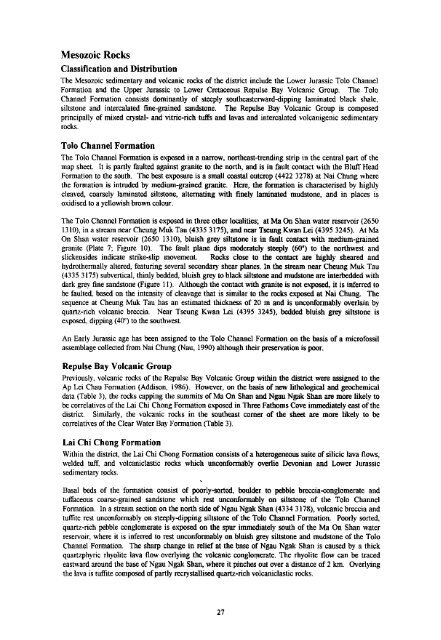Create successful ePaper yourself
Turn your PDF publications into a flip-book with our unique Google optimized e-Paper software.
Mesozoic Rocks<br />
Classification and Distribution<br />
The Mesozoic sedimentary and volcanic rocks <strong>of</strong> the district include the Lower Jurassic Tolo Channel<br />
Formation and the Upper Jurassic to Lower Cretaceous Repulse Bay Volcanic Group. The Tolo<br />
Channel Formation consists dominantly <strong>of</strong> steeply southeasterward-dipping laminated black shale,<br />
siltstone and intercalated fine-grained sandstone. The Repulse Bay Volcanic Group is composed<br />
principally <strong>of</strong> mixed crystal- and vitric-rich tuffs and lavas and intercalated volcanigenic sedimentary<br />
rocks.<br />
Tolo Channel Formation<br />
The Tolo Channel Formation is exposed in a narrow, northeast-trending strip in the central part <strong>of</strong> the<br />
map sheet. It is partly faulted against granite to the north, and is in fault contact with the Bluff Head<br />
Formation to the south. The best exposure is a small coastal outcrop (4422 3278) at Nai Chung where<br />
the formation is intruded by medium-grained granite. Here, the formation is characterised by highly<br />
cleaved, coarsely laminated siltstone, alternating with finely laminated mudstone, and in places is<br />
oxidised to a yellowish brown colour.<br />
The Tolo Channel Formation is exposed in three other localities; at Ma On Shan water reservoir (2650<br />
1310), in a stream near Cheung Muk Tau (4335 3175), and near Tseung Kwan Lei (4395 3245). At Ma<br />
On Shan water reservoir (2650 1310), bluish grey siltstone is in fault contact with medium-grained<br />
granite (Plate 7; Figure 10). The fault plane dips moderately steeply (60°) to the northwest and<br />
slickensides indicate strike-slip movement. Rocks close to the contact are highly sheared and<br />
hydrothermally altered, featuring several secondary shear planes. In the stream near Cheung Muk Tau<br />
(4335 3175) subvertical, thinly bedded, bluish grey to black siltstone and mudstone are interbedded with<br />
dark grey fine sandstone (Figure 11). Although the contact with granite is not exposed, it is inferred to<br />
be faulted, based on the intensity <strong>of</strong> cleavage that is similar to the rocks exposed at Nai Chung. The<br />
sequence at Cheung Muk Tau has an estimated thickness <strong>of</strong> 20 m and is unconformably overlain by<br />
quartz-rich volcanic breccia. Near Tseung Kwan Lei (4395 3245), bedded bluish grey siltstone is<br />
exposed, dipping (40°) to the southwest.<br />
An Early Jurassic age has been assigned to the Tolo Channel Formation on the basis <strong>of</strong> a micr<strong>of</strong>ossil<br />
assemblage collected from Nai Chung (Nau, 1990) although their preservation is poor.<br />
Repulse Bay Volcanic Group<br />
Previously, volcanic rocks <strong>of</strong> the Repulse Bay Volcanic Group within the district were assigned to the<br />
Ap Lei Chau Formation (Addison, 1986). However, on the basis <strong>of</strong> new lithological and geochemical<br />
data (Table 3), the rocks capping the summits <strong>of</strong> Ma On Shan and Ngau Ngak Shan are more likely to<br />
be correlatives <strong>of</strong> the Lai Chi Chong Formation exposed in Three Fathoms Cove immediately east <strong>of</strong> the<br />
district. Similarly, the volcanic rocks in the southeast corner <strong>of</strong> the sheet are more likely to be<br />
correlatives <strong>of</strong> the Clear Water Bay Formation (Table 3).<br />
Lai Chi Chong Formation<br />
Within the district, the Lai Chi Chong Formation consists <strong>of</strong> a heterogeneous suite <strong>of</strong> silicic lava flows,<br />
welded tuff, and volcaniclastic rocks which unconformably overlie Devonian and Lower Jurassic<br />
sedimentary rocks.<br />
Basal beds <strong>of</strong> the formation consist <strong>of</strong> poorly-sorted, boulder to pebble breccia-conglomerate and<br />
tuffaceous coarse-grained sandstone which rest unconformably on siltstone <strong>of</strong> the Tolo Channel<br />
Formation. In a stream section on the north side <strong>of</strong> Ngau Ngak Shan (4334 3178), volcanic breccia and<br />
tuifite rest unconformably on steeply-dipping siltstone <strong>of</strong> the Tolo Channel Formation. Poorly sorted,<br />
quartz-rich pebble conglomerate is exposed on the spur immediately south <strong>of</strong> the Ma On Shan water<br />
reservoir, where it is inferred to rest unconformably on bluish grey siltstone and mudstone <strong>of</strong> the Tolo<br />
Channel Formation. The sharp change in relief at the base <strong>of</strong> Ngau Ngak Shan is caused by a thick<br />
quartzphyric rhyolite lava flow overlying the volcanic conglomerate. The rhyolite flow can be traced<br />
eastward around the base <strong>of</strong> Ngau Ngak Shan, where it pinches out over a distance <strong>of</strong> 2 km. Overlying<br />
the lava is tuffite composed <strong>of</strong> partly recrystallised quartz-rich volcaniclastic rocks.<br />
27

















